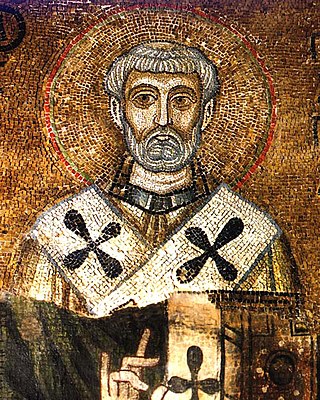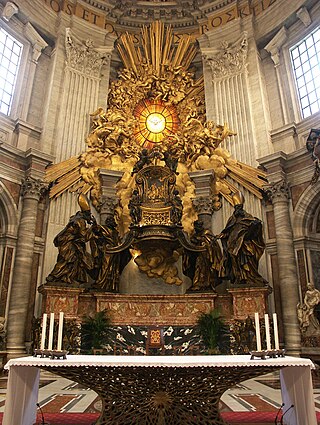Year 258 (CCLVIII) was a common year starting on Friday of the Julian calendar. At the time, it was known as the Year of the Consulship of Tuscus and Bassus. The denomination 258 for this year has been used since the early medieval period, when the Anno Domini calendar era became the prevalent method in Europe for naming years.

Pope Anacletus, also known as Cletus, was the bishop of Rome, following Peter, and Linus. Anacletus served between c. AD 79 and his death, c. AD 92. Cletus was a Roman who, during his tenure as pope, ordained a number of priests and is traditionally credited with setting up about twenty-five parishes in Rome. Although the precise dates of his pontificate are uncertain, he "...died a martyr, perhaps about 91". Cletus is mentioned in the Roman Canon of the mass; his feast day is April 26.

Pope Clement I was bishop of Rome in the late first century AD. He is listed by Irenaeus and Tertullian as the bishop of Rome, holding office from 88 AD to his death in 99 AD. He is considered to be the first Apostolic Father of the Church, one of the three chief ones together with Polycarp and Ignatius of Antioch.

March 21 - Eastern Orthodox liturgical calendar - March 23

April 18 - Eastern Orthodox liturgical calendar - April 20

June 22 - Eastern Orthodox Church calendar - June 24

July 11 - Eastern Orthodox Church calendar - July 13

The Chair of Saint Peter, also known as the Throne of Saint Peter, is a relic conserved in St. Peter's Basilica in Vatican City, the sovereign enclave of the Pope inside Rome, Italy. The relic is a wooden throne that tradition claims belonged to the Apostle Saint Peter, the leader of the Early Christians in Rome and first Pope, and which he used as Bishop of Rome. The relic is enclosed in a sculpted gilt bronze casing designed by Gian Lorenzo Bernini and constructed between 1647 and 1653. In 2012, Pope Benedict XVI described the chair as "a symbol of the special mission of Peter and his Successors to tend Christ's flock, keeping it united in faith and in charity."

November 6 - Eastern Orthodox liturgical calendar - November 8

December 31 - Eastern Orthodox liturgical calendar - January 2

January 1 - Eastern Orthodox liturgical calendar - January 3

January 22 - Eastern Orthodox liturgical calendar - January 24
Hieromartyr Clement, Bishop of Ancyra or simply Clement of Ancyra was a bishop who served during the rule of Roman emperor Diocletian. He was arrested by Roman authorities and tried by Diocletian. Emperor Diocletian attempted to convert Clement to Paganism but Clement refused and withstood tremendous torture. Clement was eventually beheaded by a Roman soldier whilst he was celebrating the Divine Liturgy in the year 312. He is venerated on 23 January according to the Gregorian calendar and on 5 February according to the civil or Gregorian calendar equivalent of 23 January in the Julian calendar by Orthodox Christians keeping this calendar, which includes all of them in some countries and traditionalist Orthodox Christians including Genuine or Authentic Orthodox Christians, True Orthodox Christians and Catacomb Orthodox Christians everywhere, together with his disciple Agathangelus of Rome.
The history of Ankara can be traced back to the Bronze Age Hatti civilization, which was succeeded in the 2nd millennium BC by the Hittites, in the 10th century BC by the Phrygians, and later by the Lydians, Persians, Macedonians, Galatians, Romans, Byzantines, Seljuks, and Ottomans.

Prior to the revision of the Anglican Church of Canada's (ACC) Book of Common Prayer (BCP) in 1962, the national church followed the liturgical calendar of the 1918 Canadian Book of Common Prayer. Throughout most of the twentieth century, the situation in Canada resembled that which pertained in much of the Anglican Communion: There was uncertainty as to whether post-Reformation figures could or should be commemorated. In the words of the calendar's introduction, "New names have been added from the ancient calendars, and also from the history of the Anglican Communion, without thereby enrolling or commending such persons as saints of the Church." The 1962 revision added twenty-six post-Reformation individuals, as well as commemorations of the first General Synod and of "The Founders, Benefactors, and Missionaries of the Church in Canada." Of the calendar days, twenty-eight were highlighted as "red-letter days" — that is, days of required observation.

The First Martyrs of the Church of Rome were Christians martyred in the city of Rome during Nero's persecution in 64. The event is recorded by both Tacitus and Pope Clement I, among others. They are celebrated in the Roman Catholic Church as an optional memorial on 30 June.

November 22 - Eastern Orthodox liturgical calendar - November 24

November 28 - Eastern Orthodox liturgical calendar - November 30

December 9 - Eastern Orthodox liturgical calendar - December 11

December 26 - Eastern Orthodox liturgical calendar - December 28






